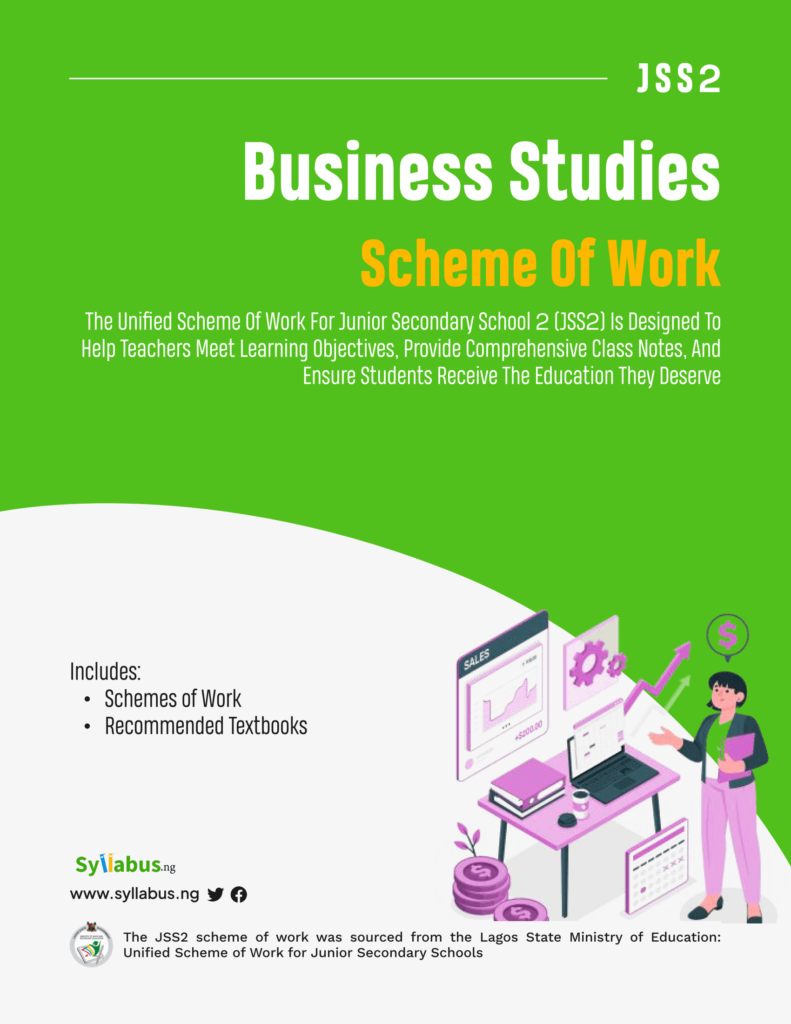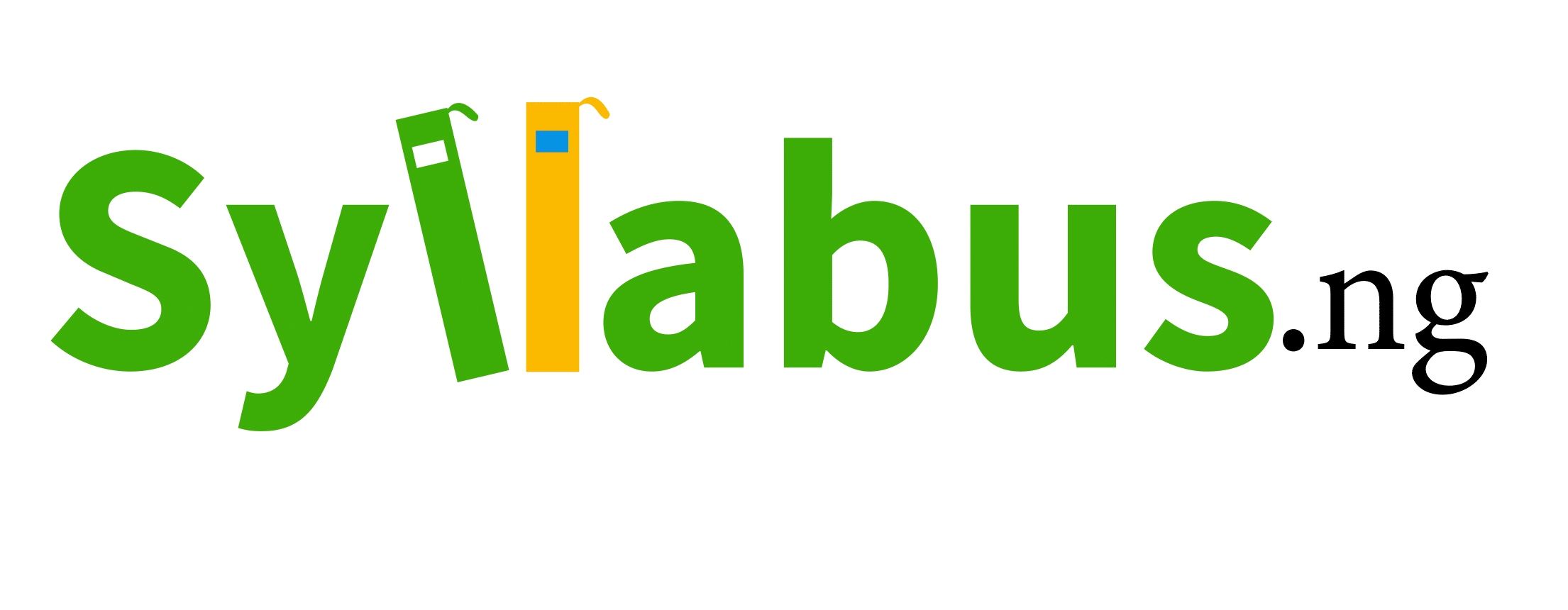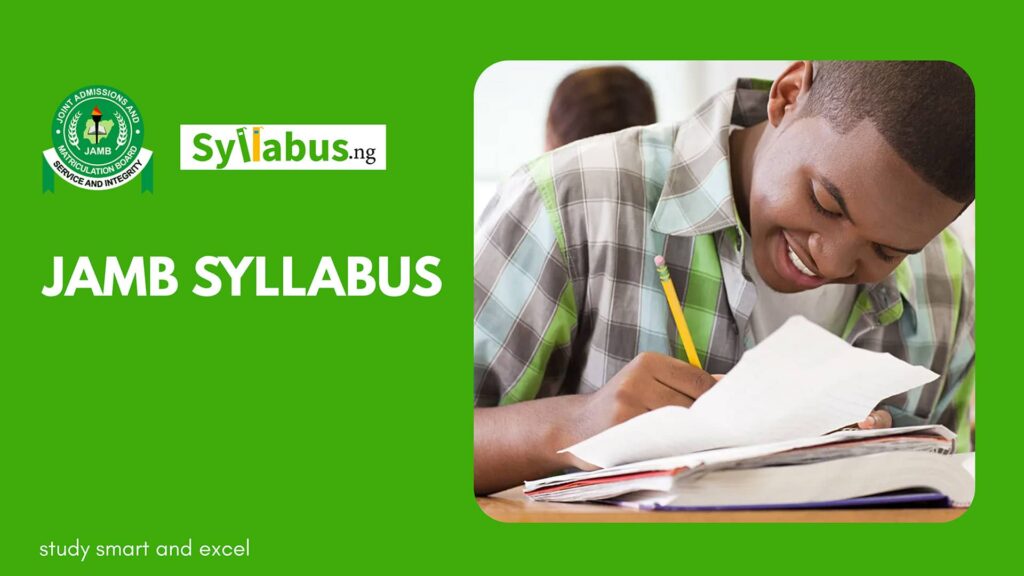JSS2 Business Studies Scheme of Work
Download the Junior Secondary School 2 (JSS2) Unified Scheme of Work for Business Studies to serve as a guide for educators

Home » JSS2 Scheme of Work » JSS2 Business Studies Scheme of Work
Home » JSS2 Scheme of Work » JSS2 Business Studies Scheme of WorkAbout JSS2 Business Studies Scheme of Work
In Nigeria, Business Studies for Junior Secondary School 2 (JSS2) provides an initial exploration into the principles and operations of business, to provide students with fundamental knowledge applicable to both academic pursuits and real-world scenarios.
In JSS2, students are introduced to various aspects of business, encompassing trading, marketing, bookkeeping, business operations, and office procedures. Through theoretical lessons and practical exercises, they gain insights into the functions of businesses in society and the significance of business operations.
The scheme of work is crafted to cultivate critical thinking, problem-solving abilities, and a foundational grasp of economic structures. It also helps students foster their potential to identify opportunities for innovation and enterprise in the future.
Assessment Guide
In junior secondary schools, how students are assessed in Business Studies can differ from school to school. However, typically, they are evaluated through tests or quizzes (Continuous Assessment Tests) and end-of-term exams.
Grading usually follows a scale from A to F, with A representing excellent performance, typically scoring around 70% or 80%, and F indicating failure, usually below 50% or 45%
Download JSS2 Business Studies Scheme of Work

Know what’s expected of you as an educator
Download the Lagos State Unified Scheme of Work for JSS2 Business Studies
JSS2 First Term Scheme of Work for Business Studies
| LAGOS STATE MINISTRY OF EDUCATION: UNIFIED SCHEMES OF WORK FOR JUNIOR SECONDARY SCHOOL | ||
| Business Studies Scheme of Work for Junior Secondary School 2(JSS2) | ||
| Class | J.S.S 2 | |
| Subject | Business Studies | |
| Term | First Term | |
| Week | Topic | Breakdown |
| 1 | THE RECEPTION OFFICE | I. Describe the Reception Office II. Explain the Meaning of Receptionist III. State the Importance of a Receptionist IV. List the Qualities of Receptionist V. Outline the Duties of a Receptionist VI. State How to Treat Visitors VII. Explain Appropriate Office Dress Code VIII. Outline the Procedure for answering the Telephone IX. Documents Handled by the Receptionist X. Identify and Design Visitor’s book, Request Form |
| 2 | OFFICE | I. State and Explain Types of Correspondence Records II. State the Uses of Correspondence Records III. List ways through which Mail comes into an Organization IV. Outline the procedure for Handling Correspondence V. Handling of Mail |
| 3 | OFFICE DOCUMENT | I. Explain the term Office Document II. Enumerate the Types of Office Document –Sales Department III. Preparation IV. List the uses of Sales Documents V. Mention the uses of Purchase Documents – Preparation, Uses |
| 4 | TRADE | I. Explain the Meaning of Trade II. List Importance of Trade III. Forms of trade – Home Trade, Foreign Trade |
| 5 | AIDS TO TRADE | I. Describe forms of trade – Banking, Insurance, Advertising, Communication, Transport and television Warehousing II. Explain the services that made Trade Easy III. Roles of Custom of the Channels of Distribution IV. Identify licensed Channels Vendors |
| 6 | MARKET | I. Define the term Market II. List the Features of a Market III. Types – Capital Market and Money Market IV. Commodity Market Institutions and Instruments traded in each Market |
| 7 | CAREER IN THE CAPITAL MARKET | I. Mention the Career opportunities available in the Capital Market II. Buying and Selling III. Explain Buying and Selling by Cash and (or) Credit IV. Transactions – Cost of sales, Make up, Turn over, Profit and loss. |
| 8 | DISTRIBUTION | I. Explain the meaning of distribution II. Channels of Distribution – Producer/Manufacturer, Wholesaler, Retailer and Consumer III. List the Agents involved in Distribution IV. Functions of each of the Channels of Distribution |
| 9 | DISTRIBUTION | I. Licensed Chemical Vendors II. Identify Safe Ways of Handling Chemicals III. Handling and Distribution of Chemical IV. Effects of Wrong Handling of Chemicals V. When Production Ends |
| 10 | BANK SERVICE | I. Define Commercial Bank II. Explain the Services provided by the Banks III. Ethical Issues in Banking |
| 11 | REVISION | |
| 12 | EXAMINATION | |
JSS2 Second Term Scheme of Work for Business Studies
| Term | Second Term | |
| Week | Topic | Breakdown |
| 1 | INSURANCE | I. Define Insurance II. Explain Services provided by Insurance Companies III. Mention Types of Insurance – Fire, Vehicle, Burglary, Money, Life Insurance, Pension and Health IV. Benefit of Insurance |
| 2 | PERSONAL QUALITIES OF AN ENTREPRENEUR | Mention the Personal Qualities of Entrepreneur Qualities of Entrepreneur |
| 3 | BUSINESS OPPORTUNITIES | I. Define Business Opportunities II. Types – Local, National and International |
| 4 | CONSUMER RIGHT | I. Meaning of Consumer Right II. Origin of Consumerism III. Eight Universal Consumer Right IV. Identify Ways and Manners of Consumer Right in the Society, Nation and Communities at Large |
| 5 | RESPONSIBILITIES OF A CONSUMER | I. Meaning of Consumer Responsibilities II. Responsibilities of the Consumers III. Explain each of the Responsibilities of a Consumer |
| 6 | SHOPPING TIPS | I. Meaning of Needs and Wants II. Differences between Needs and wants III. Making Decision about Needs and Wants IV. Improve Buying of Needs and Wants V. Effects of Pure Buying in Needs and Wants VI. After Sales Services – Warranty, Installation, etc VII. State the Steps involving in Making Decision about Needs and Wants VIII. Explain Impulse Buying and Its Effects IX. Identify after Sales and Services Available to Consumers on products and Services and their Important Areas |
| 7 | BOOK KEEPING | I. Ethnics II. Explain Transparency Accountability and Probity III. State the Need for Transparency, Accountability and Probity (TAP) in Public Domain IV. List Attributes of Transparency, Accountability and Probity V. Describe Challenges contacted by the Lack of TAP VI. Examine Solution of TAP VII. Explain the process and its operation. |
| 8 | LEDGER ENTRIES | I. Meaning of Ledger II. Identify the Items on the Ledger – Date, Particulars, Discounts, Folio and Amounts (Cash and Bank) III. Record of Cash Receipt and Cash Payments IV. How to Record Cash received and Payment V. Discount Received, Discount Allowed, and Contra Entries |
| 9 | PETTY CASH BOOK | I. Meaning of Petty Cash Book II. Columns in a Petty Cash Book III. Recording Receipts and Payment on the Petty Cash Book IV. Imprest system – Cash flow Imprest, Imprest System, Retirement and Reimbursement V. Analyse the items of expeditions in the Petty Cash Book VI. Who is a Petty Cashier? V. State the Need for keeping Petty Cash Book VI. Preparation/Format of a Petty Cash Book |
| 10 | CASH BOOK | I. Meaning of Cash Book II. Types of Cash Book – Single Column Cash Book, Two column Cash Book III. Item as a Cash Book IV. Cash column, Bank Column and Discount Column V. Preparation of a Cash Book VI. Records Cash Receipts in a Cash Book VII. Records Bank Transaction and Cash Book VIII. Differentiate between Cash Book and Petty Cash |
| 11 | REVISION | |
| 12 | EXAMINATION |
JSS2 Third Term Scheme of Work for Business Studies
| Term | Third Term | |
| Week | Topic | Breakdown |
| 1 | PRINTERS CORRECTION SIGNS | I. Proof Reading Marks and Signs Identification II. Demonstrate the use of Proof Reader Sign |
| 2 | SPEED DEVELOPMENT AND ACCURACY SKILLS | I. Keyboard Factor by practicing Alphabetic Sentence Drill II. Demonstrate improved Techniques by Key loading one line Sentence Drill Accurately III. Accuracy and Speed Drills IV. Speed Burst at one to ten minutes (Keyboard for ten minutes at 20 words per minutes with 98% accuracy. |
| 3 | TECHNIQUES DEVELOPMENT IN KEYBOARDING | I. Math Table Techniques of Wing they create Table Function II. The spec Regulator – Description, Uses, Techniques of Uses III. Enter Key, Description, Uses, Techniques of Use IV. Demonstrate the use of the insert table function V. Demonstrate the use of enter keys |
| 4 | PARAGRAPHING | I. Mention the Different Method of Paragraphing II. Identifying the Different Method of Paragraphing III. Demonstrate the use of Different Method of Paragraphs |
| 5 | PAGE SETTING | I. Different Types of Page Setup II. Choose the correct alignment – Left – Centre, Right – Justification III. Production of Documents |
| 6 | MEMORANDUM | I. State what a Memorandum is. II. List features of a memorandum. III. Format IV. Procedure of a Memorandum |
| 7 | EMAILS | I. Define Emails II. Mention the Features at an Email III. Formatting IV. Send an e-mail |
| 8 | OFFICE PROCEDURE | I. Explain the Meaning of Office Procedure II. List the importance of Office Procedure III. Way and Manners of Preparing Bills, Invoice and Receipt |
| 9 | OFFICE EQUIPMENT | I. Explain the Meaning of Office Equipment II. Identify Office Equipment III. List Types of Office Equipment IV. List Importance of Office Equipment V. Explain Use(s) of the Different Office Equipment VI. Explain Care of Office Equipment |
| 10 | REVISION | |
| 11 | EXAMINATION | |
| 12 | EXAMINATION |
Recommended Business Studies Textbooks for Junior Secondary School 2
The recommended Business Studies textbooks for JSS2 include:
- Spectrum Business Studies for JSS, Book 2 – Revised Edition
- Macmillian Junior Secondary School Business Studies, Book 2.
- WABP Junior Secondary Business Studies 2; Authors – Egbe T. Ediametalor, Grace I. MakeriyahaYa, Kate O. Osu-Nwufo, Titilayo G. Oladunjoye – New Edition (WABP)
- Model Comprehensive Business Studies with Workbook for JSS2 by Ebokasi A.R, Nwufo T.I, et al – New Age Press Ltd JSS 2
- Business Studies/workbook for JSS2 by Ahukannah, L.I, Akpomi, M.E et al – University press
All JSS2 Scheme of Work
Download JSS2 Business Studies Scheme of Work

Know what’s expected of you as an educator
Download the Lagos State Unified Scheme of Work for JSS2 Business Studies











